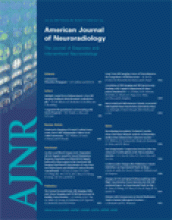Abstract
BACKGROUND AND PURPOSE: The timely re-establishment of intracranial perfusion, the effective prevention of early recurrent strokes, and the limitation of the incidence of reperfusion injury are the major factors that are key to successful treatment of patients with hyperacute stroke who had severe ipsilateral cervical internal carotid artery (ICA) stenosis. In an effort to reduce both the extent of the ongoing neurologic injury and the risk of early recurrent stroke, we have adopted an aggressive combined endovascular approach of intracranial thrombolysis and cervical carotid stent placement during the hyperacute phase. We report on the results of 5 such consecutive patients who presented to our center from January 2003 through January 2005.
MATERIALS AND METHODS: From January 2003 through January 2005, 5 consecutive patients presented to our center with hyperacute strokes and severe ipsilateral cervical ICA stenosis. All were treated with emergent carotid stent placement and intra-arterial thrombolysis. The medical records were reviewed and summarized.
RESULTS: One patient died. The remaining 4 patients had an average hospital stay of 4 days (range, 3–5 days) and a mean National Institutes of Health Stroke Scale (NIHSS) score of 2 (range, 0–3) at the time of discharge. With a mean clinical follow-up of 11 months (range, 6–24 months), all had excellent functional outcome with a modified Rankin score of 0 or 1.
CONCLUSIONS: Data on emergent carotid stent placement in the hyperacute management of stroke are limited. The summarized experience in these 5 patients demonstrates the feasibility of this aggressive therapeutic strategy that may bring about a good outcome.
- Copyright © American Society of Neuroradiology












